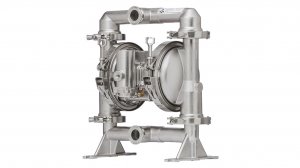Engineering solutions provider BMG’s range of Ingersoll Rand ARO fluid management equipment comprises Food and Drug Administration- (FDA-) compliant, air-operated, diaphragm pumps that provide solutions for the food and beverage sector, as well as in pharmaceuticals and cosmetic pumps applications.
ARO sanitary pumps not only enhance product purity and ensure an easy clean-out in environments that require the highest standards of cleanliness, but also allow for the safe operation at elevated temperatures.
“The ARO Expert (EXP) line of pumps, which has been designed to transfer fluids efficiently and safely, ensures high reliability and typically yields about 30% better flow rates than other types of pumps. Since fluids are transferred efficiently and gently by ARO pumps, the shelf life of the liquid is often extended. The gentle pumping action will not froth or separate fluids, which improves end-product quality,” explains BMG national product manager for pumps Joe Pinheiro.
The robust ARO pumps can handle high-volume transfer and dispensing applications, also optimising total cost of ownership for users.
“All ARO EXP pumps feature a patented unbalanced air valve design, which prevents stalling issues associated with conventional pumps. Exhaust valves effectively divert cold exhaust air from ice-prone components to prevent freezing and minimise downtime.”
These pumps can even pass large shear-sensitive solids without degradation or heat build-up and are also designed to run dry, thus eliminating the risk of pump damage, he adds.
As an expansion to the standard double diaphragm pumps, BMG now offers plant managers and maintenance engineers a reliable choice of two pump ranges for sanitary applications.
Pumps Range
BMG’s ARO SD series features a quick knock-down compression clamp system to facilitate easier cleaning and maintenance. The compression clamp band design also facilitates rapid disassembly and reassembly of components for inspection and maintenance.
The SD series would be offered only where pumps need to be stripped down daily or regularly, and special add-on features are required, says Pinheiro.
The SD series’ flow rates are optimised for improved overall performance, the electro-polished stainless steel 316L construction is FDA-compliant and these robust pumps have a higher temperature capability.
“The PM series, which is bolted, is cheaper than the SD series and would be our first-choice recommendation to clients if there are no add-on features required.
The ARO PM series diaphragm pumps are also constructed from electropolished stainless steel 316 L but features a bolted construction with all stainless steel hardware. Centre sections are available in aluminium, polypropylene or stainless steel.
All internal wetted surfaces must be completely smooth – consequently adding to the sanitary standards of the pumps – to prevent the build-up of any product, which could cause bacteria growth.
An optional single-piece composite polytetrafluoroethylene (PTFE) diaphragm minimises the number of collection points for the fluid being pumped, which accelerates disassembly, cleaning and reassembly.
The optional electronic interface integrates easily with personal computer or programmable logic controller systems and the ARO controller helps to reduce waste and increase productivity.
In a recent ARO case study at a leading local brewery, electric-powered centrifugal pumps were replaced with ARO pumps, which resulted in an increase in production capacity of between 10% and 15%.
According to the customer, the key to the success of maintaining the quality of beer and getting it quicker to the market has been in the careful pump selection.
Although the electric-powered centrifugal pumps previously used by the brewery provided high power, these pumps required operation on a continuous cycle. The constant pumping of the beer using an impeller pump introduced more oxygen into the beer, causing foam that affected the flavour.
Pinheiro says that different types of pumps can be used for each application.
For example, a centrifugal pump can be used to pump many types of liquids, but in the case of paint or ink, the speed of the impeller in the casing can cause shearing of the liquid. If any air enters the pump, the pump will cavitate and lose efficiency.
“With a diaphragm pump, they can run dry, so if they suck any air, they will not cavitate or incur any damage. Diaphragm pumps do not stir up liquids, so there will not be shearing of the liquid,” he explains.
Factory-installed options allow for customising the pumps to specific application requirements.
“It is important to ensure that diaphragms are replaced before they rupture. If they are replaced, only the wet-end kit needs to be replaced, which is a quick and simple procedure. “If a diaphragm bursts, liquid will get into the air side of the pump and that could result in the air motor also requiring attention, extending the downtime required for maintenance,” concludes Pinheiro.
Edited by: Zandile Mavuso
Creamer Media Senior Deputy Editor: Features
EMAIL THIS ARTICLE SAVE THIS ARTICLE
ARTICLE ENQUIRY
To subscribe email subscriptions@creamermedia.co.za or click here
To advertise email advertising@creamermedia.co.za or click here













